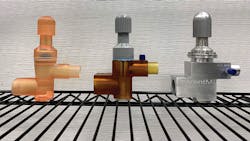Breakthrough Ventilator Splitter with Individual Pressure Capability
Researchers at the University of Michigan, collaborating with Autocam Medical, have tackled the COVID-19 crisis of potential ventilator shortages globally and developed VentMI in remarkable time—from prototype to available for use in under a month. This new ventilator splitter overcomes a previously critical limitation for the shared use of these devices. Previous splitters could deliver only one pre-set pressure to patients even though each patient requires a unique pressure tailored to their lung size and degree of disease. Excessive volume or pressure can cause lung trauma, thereby limiting the ability to share a ventilator.
Conceived only weeks ago by Dr. Kyle VanKoevering of the Department of Otolaryngology-head and neck surgery at Michigan Medicine and an associate faculty member in the Department of Biomedical Engineering, the new splitter was designed, prototyped, tested and received Emergency Use Authorization (EUA) from the FDA. In less than a week, Autocam Medical was mobilized to implement Design for Manufacturing (DFM) processes and started manufacturing the VentMI. Autocam Medical is poised to make hundreds of new devices before the end of April.
A new company formed by U-M inventors, MakeMedical LLC, has licensed the technology from U-M and will provide VentMI at cost to other institutions. Autocam Medical is providing its manufacturing services at cost, as well. Of significant note, the VentMI costs only one-hundredth that of a new ventilator, thereby helping to reduce vent costs into the future as well.
“We’re extremely grateful to have been asked to participate in the creation of this vital new product,” commented John Kennedy, CEO of Autocam Medical. “And we’re very proud of our team’s ability to go from prototype through manufacturing, engineering, to finished product in a matter of days to help meet this crucial need for the healthcare community.”
According to Owen Tien, CEO of 3-D printing company, Thingsmiths, a co-developer of VentMI and co-founder of MakeMedical, “Autocam Medical’s professionalism, speed, and quality of work is world-class. Their ability to move our components beyond 3D-printed prototypes has resulted in a product we can stand behind, and we are proud to partner with them.”
Added Kennedy, “This is truly a great example of the power of innovation and collaboration between multiple partners in successfully tackling an important challenge under the most difficult circumstances presented by the pandemic.”
